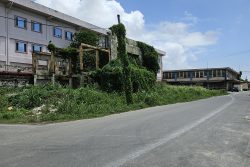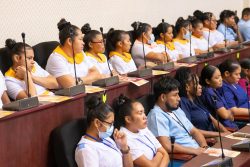This view was expressed some time ago by former Barbados Prime Minister, Owen Arthur, who, at the same forum, made the point that a primary factor in the worsening crime situation in the region is that “we have lost our way because our core cultural values have been lost, exchanged instead for values originating extra-regionally.
I share that view wholeheartedly and I pose this question: Should Guyana in its tourism thrust and under the umbrella of heritage tourism try to reclaim what is left of our cultural identity?
But what exactly is heritage tourism. Given the heightened level of public exposure that tourism is receiving in Guyana, most of us have at least a basic knowledge of what tourism is and the benefits – both immediate and long-term – that can accrue to the country from the tourism product.
According to the world tourism organization, heritage tourism is travel that is motivated by a desire to experience the authentic, natural, historic and cultural resources of a community or region, or to experience the places, artifacts and activities that authentically represent the stories and people of the past and present.
Interestingly enough, heritage tourism is one of the fastest growing niche market segments in the travel industry today and has become a major component of the economic development efforts for rural and urban areas alike.
This sustained growth has been fuelled by economics. According to a recent study by the Travel Industry Association of America, people who engage in historic and cultural activities, spend more, do more and stay longer than other types of travellers.
In 2004, according to the report, visiting historic sites ranked second to shopping in the list of tourist activities, the report further added.
“Baby boomers” in particular wish to experience history through travel, visiting the authentic places where significant events occurred or made relevant contributions to the development of a city or country.
So what are the implications of these facts for the development of heritage tourism in Guyana?
The start up cost for creating a new tourism product as against the development of an already exisiting one, is much more prohibitive. Heritage tourism uses assets, historic and natural resources, rather than creating and building new attractions.
Destinations which have been seriously promoting this segment look to the past for a sustainable future.
Secondly, and for the longest while, the visitor arrival figures have been indicating that 50 per cent of our visitor market originate from the USA. Yet there is no nor has there been any focused marketing at this already captured and lucrative market.
Any marketing strategy would have to be able to target and meet the needs of both the diaspora and the American – born tourist alike. This strategy would also have to be more focused on the European market which represents 9% of the total market share and there is enough documented evidence to support the claim that the European market is very hungry for new cultural experiences.
Accessibility has always been difficult in terms of air transportation and given the situation as it is, this will continue to impact on the successful targeting of the European market.
So how do we get started? First, we need to bring together the various interest groups. Heritage tourism brings together many different perspectives – preservationists, tourism personnel economic developers, the arts, humanities, museums and elected municipal officials – to name a few, who, by working together under the theme ‘tourism is team work’, can accomplish much more than they possibly can by working alone.
The National Heritage Register as complied by the National Trust must seek administrative approval for the buildings and sites in the register to be given some form of public recognition, Rhis applies particularly to those buildings that are privately owned and maintained. There is no denying the international appeal and prestige that will accrue to the capital city if the UNESCO plan to have sections of Georgetown declare heritage sites can be realized.
Secondly, we need to find the ‘fit’ – so to speak – between the community and tourism. A good cultural heritage tourism programme balances the needs of visitors with those of citizens residents. Every community has a different capacity for tourism and it is important that communities be involved in shaping the orientation of their respective tourism products.
Thirdly, we need to bring our heritage sites and programmes ‘to life.’ Creative ways must found to engage visitors, to draw their attention to those sites and to ensure that the sites can provide memorable experiences. Interactive experiences that engage all of the visitors’ five senses must be explored and implemented in a user/visitor friendly manner. At the same time Town/Village Day celebrations must be initiated in an effort to commemorate the historical experiences of those communities. Folk festivals, particularly, are ideal media through which people’s heritage can be commemorated.
Events such as, Mashramani, the Easter kite-flying tradition and the Rupununi rodeo have over the years not benefited from really aggressive marketing.
The interest that has been demonstrated in tourism by some indigenous communities have given rise to significant opportunities to create ‘tourism villages’ that allow visitors to ‘sample’ those communities,
Fourthly, there is need for us to focus on authenticity of the product that we offer. The contemporary traveller is, for the most part, well-informed and expect that sites and relics will genuinely reflect the heritage of the country.
A visit to Hopetown on soiree night, for example, ought to expose the visitor to traditional dances , song and cuisine and to the memorable experience of a libation ceremony.
Fifthly, it is vitally important that we preserve and protect our heritage resources. We must ensure that those historic resources that comprise our cultural heritage are adequately protected for the enlightenment of future generations.
Challenges facing the
development of heritage
tourism
The biggest challenge confronting the development of a heritage tourism product lies in ensuring that successful marketing does not result in the destruction of the product. Visitor arrivals can place heavy demands on community infrastructure. An integral part of the promotion of heritage tourism, therefore, is to develop a plan that attracts visitors and generates revenue while protecting and preserving both the relics and the ‘character’ of the community,
Among the benefits to be derived from heritage tourism are:
Entrepreneurial and job-creation opportunities,
Increases in tax revenues.
Diversification of the economy.
Creation of opportunities for economic partnerships.
Attracting a new genre of visitors to Guyana
Generating a local interest in the history and heritage of the country.
Preserving Guyana’s traditional culture.
Generating local investment in important historic buildings and sites.
Building community pride in heritage
Conclusions and
recommendations
An appropriate starting point would be to undertake a technical assessment of what the various communities have to offer that can add to the inventory of heritage resources. These should include historic sites and buildings and supporting visitor services. The inventory should also take account of the organizational capabilities of the communities in which these sites are located as well as the ability of those communities to protect, preserve and effectively market those resources.
The development of these heritage locations must also be attended by effective planning and organization that ensures optimum use of human and financial resources and the creation of a vision for the future of those heritage locations. C
ritically, the choices that are made must take account of the long term welfare of the host communities.
Finally, it is critical that the success of these heritage tourism ventures be marketed in such a manner so as to attract increased visitor interest and further investment in the development of the facilities.








